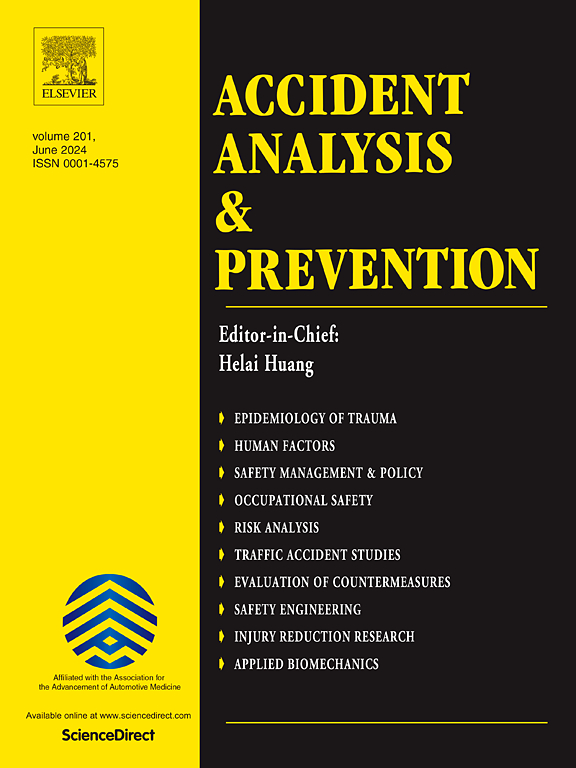Estimating safety benefit of in-vehicle work zone safety technology alerts: A counterfactual Monte-Carlo simulation approach
IF 5.7
1区 工程技术
Q1 ERGONOMICS
引用次数: 0
Abstract
Work Zone Safety Technologies (WSTs) have exhibited great potential to improve road work zone safety by detecting safety risks and providing warnings to drivers and workers involved. Yet, it remains extremely challenging to quantify the actual safety benefits of such technologies in reducing work zone intrusion accidents, mainly due to a lack of empirical data and robust evaluation methods. This paper aims to explore the patterns of drivers’ behavioural responses when approaching work zones and estimate the safety benefits of in-vehicle WSTs. First, a VR-based driving simulation experiment was conducted to collect human behavioural data on drivers’ responses when approaching work zones in critical scenarios. Second, a Linear Mixed Effect (LME) model was developed to capture the impact of in-vehicle WST alerts and scenario criticality, i.e., speed and Time-to-Collision (TTC), on drivers’ behavioural responses. Finally, the safety benefits of in-vehicle WST alerts were estimated through counterfactual Monte-Carlo simulations of vehicle trajectories. The findings highlight the mechanism by which in-vehicle WST alerts improve driver response in various critical driving scenarios involving work zones and provide crucial evidence for future decision-making regarding the evaluation of WSTs.
估计车内工作区安全技术警报的安全效益:一种反事实蒙特卡罗模拟方法
工作区域安全技术(WSTs)通过检测安全风险并向相关司机和工人提供警告,显示出改善道路工作区域安全的巨大潜力。然而,由于缺乏经验数据和可靠的评估方法,量化这些技术在减少工作区域入侵事故方面的实际安全效益仍然极具挑战性。本文旨在探讨驾驶员在接近工作区域时的行为反应模式,并估计车载wst的安全效益。首先,通过基于vr的驾驶模拟实验,收集驾驶员在关键场景接近工作区域时的行为数据。其次,开发了线性混合效应(LME)模型,以捕捉车内WST警报和场景临界性(即速度和碰撞时间(TTC))对驾驶员行为反应的影响。最后,通过对车辆轨迹进行反事实蒙特卡洛模拟,估计了车载WST预警的安全效益。研究结果强调了车载WST警报在涉及工作区域的各种关键驾驶场景中改善驾驶员反应的机制,并为未来有关WST评估的决策提供了重要证据。
本文章由计算机程序翻译,如有差异,请以英文原文为准。
求助全文
约1分钟内获得全文
求助全文
来源期刊

Accident; analysis and prevention
Multiple-
CiteScore
11.90
自引率
16.90%
发文量
264
审稿时长
48 days
期刊介绍:
Accident Analysis & Prevention provides wide coverage of the general areas relating to accidental injury and damage, including the pre-injury and immediate post-injury phases. Published papers deal with medical, legal, economic, educational, behavioral, theoretical or empirical aspects of transportation accidents, as well as with accidents at other sites. Selected topics within the scope of the Journal may include: studies of human, environmental and vehicular factors influencing the occurrence, type and severity of accidents and injury; the design, implementation and evaluation of countermeasures; biomechanics of impact and human tolerance limits to injury; modelling and statistical analysis of accident data; policy, planning and decision-making in safety.
 求助内容:
求助内容: 应助结果提醒方式:
应助结果提醒方式:


